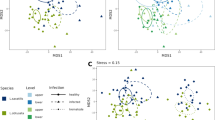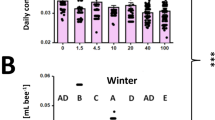Abstract
β-Carboline alkaloids are found worldwide in many plant families. Harman, harmine, and other simple β-carboline alkaloids were tested for activity against a generalist phytophagous insect, the beet army worm [Spodoptera exigua (Hubner)]. Chronic dietary exposure tests (neonate to pupa) reveal potent antifeedant and possible toxic effects. Acute dietary exposure tests on fifth-instar larvae also demonstrate antifeedant activity.
Similar content being viewed by others
References
Allen, J.F., andHolmstedt, B.F. 1980. The simple β-carboline alkaloids.Phytochemistry 19:1573–1582.
Brattsten, L.B., Wilkinson, C.F., andEisner, T. 1977. Herbivore-plant interactions: Mixed function oxidases and secondary plant substances.Science 196:1349–1352.
Cavin, J.C., andRodriguez, E. 1982. Ethnopharmacognosy of Amazonian psychoactive plants, pp. 169–177,in J.V. Martinez and D.I. Marinez (eds.). Aspects of American Hispanic and Indian Involvement in Biomedical Research. Society for Advancement of Chicanos and Native Americans in Science, Bethesda, Maryland.
Cavin, J.C., Krassner, S.M., andRodriguez, E. 1987. Plant-derived alkaloids active againstTrypanosoma cruzi.J. Ethnopharmacol. 19:89–94.
Chang, C., Castellazzi, M., Glover, T.W., andTrosko, J.E. 1978. Effects of harman and norharman on spontaneous and ultraviolet light-induced mutagenesis in cultured Chinese hamster cells.Cancer Res. 38:4527–4533.
Chou, F.Y., Hostettman, K., Kubo, I. Nakanishi, K., andTaniguchi, M. 1977. Isolation of an insect antifeedant N-methylflindersine and several benz[c]phenanthridine alkaloids from East African plants; A comment on chelerythrine.Heterocycles 7(2):969–977.
Coates, G.H., andCox, B. 1972. Harmine tremor after brain monoamine oxidase inhibition in the mouse.Eur. J. Pharmacol. 18:284–286.
Dunnet, C.W. 1955. A multiple comparison procedure for comparing several treatments with a control.Am. Stat. Assoc. J. 50:1096–1121.
Duportail, G., andLami, H. 1975. Studies of the interaction of the fluorophores harmine and harmaline with calf thymus DNA.Biochim. Biophys. Acta 402:20–30.
Hegnauer, R. 1973. Chemotaxonomie der Pflanzen, Vol. 6. Birkhauser Verlag, Basel, pp. 479, 712.
Janzen, D.H., Juster, H.B., andBell, E.A. 1977. Toxicity of secondary compounds to the seed-eating larvae of the bruchid beetleCallosobruchus maculatus.Phytochemistry 16:223–227.
Krieger, R.I., Feeny, P.P., andWilkinson, C.F. 1971. Detoxication enzymes in the guts of caterpillars: An evolutionary answer to plant defenses?Science 172:579–581.
Leonard, B.E., andStonier, P.D. 1971. The effect of some hallucinogenic and other drugs on the temperature of reserpinized mice.Psychopharmacologia (Berlin) 22:126–132.
McKenna, D.J., andTowers, G.H.N. 1981. Ultra-violet mediated cytotoxic activity of β-carboline alkaloids.Phytochemistry 20(5):1001–1004.
Meisner, J., Weissenberg, M., Palevitch, D., andAharonson, N. 1981. Phagodeterrency induced by leaves and leaf extracts ofCatkaranthus roseus in the larva ofSpodoptera littoralis.J. Econ. Entomol. 74(2):131–135.
Monache, F.D., Marini Bettolo, G.B., andBernays, E.A. 1984. Isolation of insect anti-feedants fromMaytenus rigida (Celastraceae).Z. Angew. Entomol. 97:406–414.
Moro, G.A., Graziano, M.N., andCoussio, J.D. 1975. Alkaloids ofProsopis nigra.Phytochemistry 14:827.
Murumo, F., Mishina, T., Asano, Y., andTashima, Y. 1976. The inhibitory effect of reserpine on the active sodium transport across the frog bladder.Pflugers Arch. 365:15–19.
Radford, P.J. 1967. Growth analysis formulae—their use and abuse.Crop Sci. 7:171–175.
Rivier, L., andLindgren, J. 1972. Ayahuasca, the South American hallucinogenic drink: An ethnobotanical and chemical investigation.Econ. Bot. 26(2):101–129.
Rohlf, F.J., andSokal, R.R. 1981. Statistical Tables, 2nd ed. W.H. Freeman, San Francisco. pp. 156–162.
Schoonhoven, L.M. 1972. Secondary plant substances and insects.Recent Adv. Phytochem. 5:197–224.
Waldbauer, G.P. 1968. The consumption and utilization of food by insects.Adv. Insect Physiol. 5:229–288.
Author information
Authors and Affiliations
Rights and permissions
About this article
Cite this article
Cavin, J.C., Rodriguez, E. The influence of dietaryβ-carboline alkaloids on growth rate, food consumption, and food utilization of larvae ofSpodoptera exigua (Hubner). J Chem Ecol 14, 475–484 (1988). https://doi.org/10.1007/BF01013899
Received:
Accepted:
Issue Date:
DOI: https://doi.org/10.1007/BF01013899




